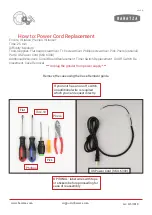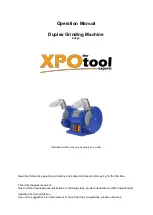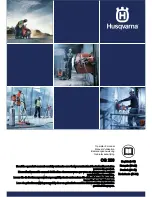
ANGLE GRINDER SAFETY INSTRUCTIONS
The electric motor has been designed for 230V and 240V only. Always check that the power supply
corresponds to the voltage on the rating plate.
Note: The supply of 230V and 240V on Ozito tools are interchangeable for Australia and New Zealand.
This tool is double insulated in accordance with AS/NZS 60745-1;
therefore no earth wire is required.
If the supply cord is damaged, it must be replaced by an electrician
or a power tool repairer in order to avoid a hazard.
Note: Double insulation does not take the place of normal safety precautions when operating this tool. The
insulation system is for added protection against injury resulting from a possible electrical insulation failure
within the tool.
Using an Extension Lead
Always use an approved extension lead suitable for the power input of this tool. Before use, inspect the
extension lead for signs of damage, wear and ageing. Replace the extension lead if damaged or defective.
When using an extension lead on a reel, always unwind the lead completely. Use of an extension lead not
suitable for the power input of the tool or which is damaged or defective may result in a risk of fire and electric
shock.
WARNING!
Read all safety warnings and all instructions.
Failure to follow the warnings and
instructions may result in electric shock, fire and/or serious injury.
Save all warnings and instructions for future reference. The term “power tool” in the warnings
refers to your mains-operated (corded) power tool or battery-operated (cordless) power tool.
1. Work area safety
a.
Keep work area clean and well lit
. Cluttered or dark areas invite accidents.
b.
Donotoperatepowertoolsinexplosiveatmospheres,suchasinthepresenceofflammableliquids,
gases or dust.
Power tools create sparks
which may ignite the dust or fumes.
c.
Keep children and bystanders away while operating a power tool.
Distractions can cause you to lose
control.
2. Electrical safety
a.
Power tool plugs must match the outlet. Never modify the plug in any way.
Do not use any adapter plugs with earthed (grounded) power tools.
Unmodified plugs and matching
outlets will reduce risk of electric shock.
b.
Avoid body contact with earthed or grounded surfaces, such as pipes, radiators, ranges and
refrigerators.
There is an increased risk of electric shock
if your body is earthed or grounded.
c.
Do not expose power tools to rain or wet conditions.
Water entering a power tool will increase the risk of
electric shock.
d.
Do not abuse the cord. Never use the cord for carrying, pulling or unplugging the power tool. Keep
cord away from heat, oil, sharp edges or moving parts.
Damaged or entangled cords increase the risk of
electric shock.
e.
When operating a power tool outdoors, use an extension cord suitable
for outdoor use.
Use of a cord suitable for outdoor use reduces the risk of electric shock.
f.
If operating a power tool in a damp location is unavoidable, use a residual current device (RCD)
protected supply.
Use of an RCD reduces the risk of electric shock.
3. Personal safety
a.
Stay alert, watch what you are doing and use common sense when operating a power tool. Do not
useapowertoolwhileyouaretiredorundertheinfluenceofdrugs,alcoholormedication.
A moment
of inattention while operating power tools may result in serious personal injury.
b.
Use personal protective equipment. Always wear eye protection.
Protective equipment such as dust
mask, non-skid safety shoes, hard hat, or hearing protection used for appropriate conditions will reduce
personal injuries.
c.
Prevent unintentional starting. Ensure the switch is in the off-position before connecting to power
source and/or battery pack, picking up or carrying the tool.
Carrying power tools with your finger on the
switch or energising power tools that have the switch on invites accidents.
d.
Remove any adjusting key or wrench before turning the power tool on.
A wrench or a key left attached to a rotating part of the power tool may result
in personal injury.
e.
Do not overreach. Keep proper footing and balance at all times.
This enables better control of the power
tool in unexpected situations.
f.
Dress properly. Do not wear loose clothing or jewellery. Keep your hair, clothing and gloves away
from moving parts.
Loose clothes, jewellery or long hair can be caught in moving parts.
g.
If devices are provided for the connection of dust extraction and collection facilities, ensure these
are connected and properly used.
Use of dust collection can reduce dust-related hazards.
4. Power tool use and care
a.
Do not force the power tool. Use the correct power tool for your application.
The correct power tool will
do the job better and safer at the rate for which it was designed.
b.
Do not use the power tool if the switch does not turn it on and off.
Any power tool that cannot be
controlled with the switch is dangerous and must be repaired.
c.
Disconnect the plug from the power source and/or the battery pack from the power tool before
making any adjustments, changing accessories, or storing power tools.
Such preventive safety
measures reduce the risk of starting the power tool accidentally.
d.
Store idle power tools out of the reach of children and do not allow persons unfamiliar with the
power tool or these instructions to operate the power tool.
Power tools are dangerous in the hands of
untrained users.
e.
Maintain power tools. Check for misalignment or binding of moving parts, breakage of parts and any
other condition that may affect the power tool’s operation. If damaged, have the power tool repaired
before use.
Many accidents are caused by poorly maintained power tools.
f.
Keep cutting tools sharp and clean.
Properly maintained cutting tools with sharp cutting edges are less
likely to bind and are easier to control.
g.
Use the power tool, accessories and tool bits etc. in accordance with these instructions, taking into
account the working conditions and the work to be performed.
Use of the power tool for operations
different from those intended could result in a hazardous situation.
5. Service
a.
Haveyourpowertoolservicedbyaqualifiedrepairpersonusingonlyidenticalreplacementparts.
This will ensure that the safety of the power tool
is maintained.
b.
If the supply cord is damaged, it must be replaced by the manufacturer,
its service agent or similarly qualified persons in order to avoid a hazard.
GENERAL POWER TOOL SAFETY WARNINGS
ELECTRICAL SAFETY
WARNING!
a) This power tool is intended to function as a grinder, sanding or cut-off tool.
Readallsafetywarnings,instructions,illustrationsandspecificationsprovidedwiththispower
tool.
Failuretofollowallinstructionslistedbelowmayresultinelectricshock,firand/orseriousinjury.
b) Operations such as wire brushing, or polishing are not recommended to be performed with this power
tool.
Operations for which the power tool was not designed may create a hazard and cause personal injury.
c)Donotuseaccessorieswhicharenotspecificallydesignedandrecommendedbythetool
manufacturer.
Just because the accessory can be attached to your power tool, it does not assure safe operation.
d) The rated speed of the accessory must be at least equal to the maximum speed marked on the power
tool.
Accessories running faster than their rated speed can break and fly apart
e) The outside diameter and the thickness of your accessory must be within the capacity rating of your
power tool.
Incorrectly sized accessories cannot be adequately guarded or controlled.
f)Thearboursizeofwheels,flanges,backingpadsoranyotheraccessorymustproperlyfitthespindle
of the power tool.
Accessories with arbour holes that do not match the mounting hardware of the power tool will
run out of balance, vibrate excessively and may cause loss of control.
g) Do not use a damaged accessory.
Before each use inspect the accessory such as abrasive wheels for chips
and cracks, backing pad for cracks, tear or excess wear, wire brush for loose or cracked wires. If power tool or
accessory is dropped, inspect for damage or install an undamaged accessory. After inspecting and installing an
accessory, position yourself and bystanders away from the plane of the rotating accessory and run the power tool
at maximum no-load speed for one minute. Damaged accessories will normally break apart during this test time.
h) Wear personal protective equipment.
Depending on application, use face shield, safety goggles or safety
glasses. As appropriate, wear dust mask, hearing protectors, gloves and workshop apron capable of stopping
small abrasive or work piece fragments. The eye protection must be capable of stopping flying debris generated
by various operations . The dust mask or respirator must be capable of filtrating particles generated by your
operation. Prolonged exposure to high intensity noise may cause hearing loss.
i) Keep bystanders a safe distance away from work area.
Anyone entering the work area must wear personal
protective equipment. Fragments away and cause injury beyond immediate area of operation.
j) Hold power tool by insulated gripping surfaces only, when performing an operation where the cutting
accessory may contact hidden wiring or its own cord.
Cutting accessory contacting a “live” wire may make
exposed metal parts of the power tool “live” and shock the operator.
k) Position the cord clear of the spinning accessory.
If you lose control, the cord may be cut or snagged and
your hand or arm may be pulled into the spinning accessory.
l) Never lay the power tool down until the accessory has come to a complete stop.
The spinning accessory
may grab the surface and pull the power tool out of your control.
m) Do not run the power tool while carrying it at your side.
Accidental contact with the spinning accessory
could snag your clothing, pulling the accessory into your body.
n) Regularly clean the power tool’s air vents.
The motor’s fan will draw the dust inside the housing and
excessive accumulation of powdered metal may cause electrical hazards.
o)Donotoperatethepowertoolnearflammablematerials.
Sparks could ignite these materials.
p) Do not use accessories that require liquid coolants. Using water or other liquid coolants may result in
electrocution or shock.
Kickback and related warnings
Kickback is a sudden reaction to a pinched or snagged rotating wheel, backing pad, brush or any other
accessory. Pinching or snagging causes rapid stalling of the rotating accessory which in turn causes the
uncontrolled power tool to be forced in the direction opposite of the accessory’s rotation at the point of the
binding.
For example, if an abrasive wheel is snagged or pinched by the work piece, the edge of the wheel that is entering
into the pinch point can dig into the surface of the material causing the wheel to climb out or kick out. The wheel
may either jump toward or away from the operator, depending on direction of the wheel’s movement at the point
of pinching. Abrasive wheels may also break under these conditions. Kickback is the result of power tool misuse
and/or incorrect operating procedures or conditions and can be avoided by taking proper precautions as given
below.
a)Maintainafirmgriponthepowertoolandpositionyourbodyandarmtoallowyoutoresistkickback
forces.
Always use auxiliary handle, if provided, for maximum control over kickback or torque reaction during
start-up. The operator can control torque reactions or kickback forces, if proper precautions are taken.
b) Never place your hand near the rotating accessory.
Accessory may kickback over your hand.
c) Do not position your body in the area where power tool will move if kickback occurs.
Kickback will
propel the tool in direction opposite to the wheel’s movement at the point of snagging.
d) Use special care when working corners, sharp edges etc.
Avoid bouncing and snagging the accessory.
Corners, sharp edges or bouncing have a tendency to snag the rotating accessory and cause loss of control or
kickback.
e) Do not attach a saw chain woodcarving blade or toothed saw blade.
Such blades create frequent kickback
and loss of control.
Additional safety instructions for grinding and abrasive cutting-off operations
a)Useonlywheeltypesthatarerecommendedforyourpowertoolandthespecificguarddesignedfor
the selected wheel.
Wheels for which the power tool was not designed cannot be adequately guarded and are
unsafe.
b) The guard must be securely attached to the power tool and positioned for maximum safety, so the
least amount of wheel is exposed towards the operator.
The guard helps to protect operator from broken
wheel fragments and accidental contact with wheel.
c) Wheels must be used only for recommended applications.
For example: do not grind with the side of cut-
off wheel. Abrasive cut-off wheels are intended for peripheral grinding, side forces applied to these wheels may
cause them to shatter.
d)Alwaysuseundamagedwheelflangesthatareofcorrectsizeandshapeforyourselectedwheel.
Proper wheel flanges support the wheel thus reducing the possibility of wheel breakage. Flanges for cut-off
wheels may be different from grinding wheel flanges.
e) Do not use worn down wheels from larger power tools.
Wheel intended for larger power tool is not suitable
for the higher speed of a smaller tool and may burst.
Additional safety instructions for abrasive cutting-off operations:
a) Do not “jam” the cut-off wheel or apply excessive pressure.
Do not attempt to make an excessive depth of
cut. Overstressing the wheel increases the loading and susceptibility to twisting or binding of the wheel in the cut
and the possibility of kickback or wheel breakage.
b) Do not position your body in line with and behind the rotating wheel.
When the wheel, at the point of
operation, is moving away from your body, the possible kickback may propel the spinning wheel and the power
tool directly at you.
c) When wheel is binding or when interrupting a cut for any reason, switch off the power tool and hold
the power tool motionless until the wheel comes to a complete stop.
Never attempt to remove the cut-off
wheel from the cut while the wheel is in motion otherwise kickback may occur. Investigate and take corrective
action to eliminate the cause of wheel binding.
d) Do not restart the cutting operation in the work piece.
Let the wheel reach full speed and carefully reenter
the cut. The wheel may bind, walk up or kickback if the power tool is restarted in the work piece.
e) Support panels or any oversized work piece to minimize the risk of wheel pinching and kickback.
Large
work pieces tend to sag under their own weight. Supports must be placed under the work piece near the line of
cut and near the edge of the work piece on both sides of the wheel.
f) Use extra caution when making a “pocket cut” into existing walls or other blind areas.
The protruding
wheel may cut gas or water pipes,electrical wiring or objects that can cause kickback.
Additional safety instructions for sanding operations
a) Do not use excessively oversized sanding disc paper.
Follow manufacturers recommendations, when
selecting sanding paper. Larger sanding paper extending beyond the sanding pad presents a laceration hazard
and may cause snagging, tearing of the disc or kickback.
The tool is recommended for use with a residual current device with a rated residual current of 30mA or
less.
Wehighlyrecommendthatwhenusingabrasivecuttingwheels,thatacuttingguardshouldbefittedto
your angle grinder. These cutting guards are available as a spare part and can be ordered through the
special orders desk


























